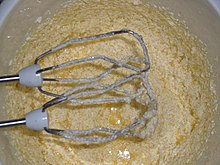Batter
Mixing batter (often, but not technically, also called batter ) is a stirred, sometimes whipped mass for making cakes and other fine baked goods , which mainly contains eggs , fat , sugar , milk or water , flour and starch . Compared to the biscuit and Viennese mass , it has a higher fat content and is therefore harder to whip. The pastries easing is partly purely physically by the introduced in the preparation of air, depending on the type pastries but also with chemical support of leavening agent (especially baking soda ) or exclusively chemically.
composition
Pancakes differ greatly in the proportions of the ingredients. The higher the fat content, the “heavier” the mass and the resulting baked goods. If the proportion of wheat starch is high compared to the amount of flour (50% to 75% of the total amount of flour and starch), the crumb will be fine-pored, loose, tender and somewhat dry, as desired for sand cakes . On the other hand, if you reduce the starch content or use only flour, as is often the case with marble cakes , the crumb becomes coarse-pored and firm. Instead of wheat starch you can also use other types such as potato or corn starch. Also, whole-wheat flour is good for batters, the pastry then gets a kernigere texture.
Sand mass is a batter which, according to the German food book, contains at least 20 parts butter or other fats and at least 20 parts whole eggs per 100 parts of total mass. A particularly heavy mass of sand is the “old German mass”, which contains eggs, sugar, fat and flour / starch in equal parts (“Gleichschwerkuchen”).
Manufacturing
It is characteristic of pancakes that the ingredients are combined and emulsified by stirring. In addition, by stirring and (depending on the recipe) also by whipping the total mass or part of the ingredients, air is worked into the mass to a greater or lesser extent and a physical loosening of the baked goods is made possible. The introduction of air reduces the density of the mass, which professional bakers determine by taking a defined volume of the mass and weighing it. Typical liter weights for batter mixes are in the range of 600–900 g / l. Sufficiently ventilated masses can be baked completely without raising agents; with other baked goods such as Americans , on the other hand, a poorly ventilated mass and the use of leavening agents are characteristic. In the bakery, these preparation steps are usually carried out with a mixer and beater, in the household with a hand mixer or with a food processor . There is no generally applicable processing method for the ingredients - the work steps vary depending on the recipe.
- For batter with a high proportion of eggs, the one-kettle method is suitable, similar to the Viennese mass , in which the egg, sugar, salt and aromas are first whipped together (often with warming to improve the emulsion) and then flour and starch and finally that Working in fat.
- If the egg content is lower, fat, sugar, egg, salt and flavorings can be stirred together until foamy, then liquid, flour and starch can be incorporated.
- If there is a high percentage of fat, such as a heavy mass of sand, a two-vessel method is suitable, in which the fat and eggs are aerated separately. A three-vessel process is also possible, in which the egg yolk and egg white are beaten again separately. However, the two- and three-vessel processes are relatively labor-intensive and expensive.
- In the one-step production process, all ingredients are first mixed together and then the mixture is whipped. For this, however, it is absolutely necessary to add whipping agents. This so-called “all-in process” is the usual procedure in industrial production and when using convenience products and baking mixes (also in the household).
Baked goods made from batter


Sponge cakes can be baked in box, Gugelhupf and other forms, as well as sheet cakes . The fine baked goods made from batter include:
- American
- Danube wave
- English cake
- Kings cake
- marble cake
- muffins
- Easter lamb (and other picture breads )
- Biscuit cake
The composition for Baumkuchen is also a batter with a high proportion of eggs and fat.
literature
- Claus Schünemann a. a .: Technology of baked goods production. Specialized textbook for bakers . 11th, revised edition. Gildebuchverlag, Alfeld (Leine) 2016, ISBN 978-3-7734-0190-8 , p. 363-368 .
- Josef Loderbauer: The confectioner's book in learning fields . 6th, updated edition. Verlag Handwerk und Technik, Hamburg 2015, ISBN 978-3-582-40203-5 , p. 406 ff .
- Claus Schünemann: Learning areas in the bakery. Production. Practice-theory textbook for professional training to become a baker . 2nd, corrected edition. Gildebuchverlag, Alfeld (Leine) 2006, ISBN 3-7734-0166-3 , p. 208, 413-417, 427-429 (main volume ; with CD-ROM).
Individual evidence
- ↑ a b c d e Claus Schünemann, Günter Treu: Technology of the production of baked goods. Specialized textbook for bakers. 10th edition. Gildebuchverlag, Alfeld / Leine 2009, ISBN 978-3-7734-0150-2 , p. 327 ff.
- ↑ a b Udo Hanneforth: Production of fine baked goods. In: Wilfried Seibel (Ed.): Fine baked goods. 2nd Edition. Behr, Hamburg 2001, ISBN 3-86022-852-8 , p. 141 ff.
- ↑ German Food Book, Guidelines for Fine Baked Goods , Section II 3
